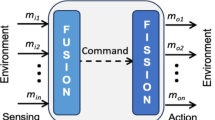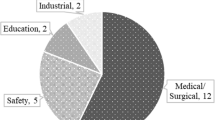Abstract
This study presents the results of the pre- and postflight clinical and physiological examination (CPE) and scientific experiment “Sensory Adaptation-2” at the Gagarin Research and Test Cosmonaut Training Center, which involved 14 Russian cosmonauts, crewmembers of long-term international spaceflights ISS-28/29 to ISS 36/37, who were in microgravity from 159 to 195 days. The cosmonauts were aged 35–50 years. The studies were conducted twice before the spaceflight (the background), as well as on days R+1(2), R+4(5), and R+8(9) after landing. In the study of visual–manual tracking (VMT), eye movements were recorded by the electrooculography method (EOG), and hand movements were recorded by a joystick (the screen represented the current tilt angle of a joystick handle). The examinations were conducted using stimulation computer programs, were presented to an examined subject on the screen of the Sensomotor hardware–software complex. The examinations took place in the dialog mode and included the EOG calibration; VMT within ±10° on the screen with blank background (the smooth linear and sinusoidal movement of a point target with a frequency of 0.16 Hz in the vertical and horizontal directions). The study estimated the time, amplitude, and velocity characteristics of visual and manual tracking (VT and MT), including the effectiveness (ec) and gain (gc) coefficients as the ratios of the amplitude and velocity of eye/hand movements to the amplitude and velocity of the visual stimulus. The study of the vestibular function (VF) was performed before and after the spaceflight using videooculography. The static torsion otolith–cervical–ocular reflex (OCOR), dynamic vestibular–cervical–ocular reactions (VCOR), vestibular reactivity, and spontaneous eye movements were assessed. The study of VF in the first postflight days has shown a sharp decrease (up to its complete absence) of static vestibular excitability accompanied by the increased dynamic reactivity of the vestibular system. The study of VTM in the first postflight days has shown a significant decrease in the ec and gc of VT as well as correlations between the parameters of VT and MT and between the parameters of VF and VT and has not found a correlation between the parameters of VF and MT. The conditions of the spaceflight have been revealed to affect the accuracy of VT more strongly than the accuracy of MT. A complete return of the characteristics of VMT and VF to the baseline was observed on R+8(9) days after the spaceflight.
Similar content being viewed by others
References
Kornilova, L.N., The tracking function of the eye under microgravity and readaptation to earth gravitation, Aviakosm. Ekol. Med., 2001, vol. 35, no. 6, p. 30.
Kornilova, L.N., Grigorova, V., Mueller, Kh., et al., The vestibular system. Intersensory interaction. Space perception and spatial orientation. Space adaptation syndrome and space motion sickness. Orbital Station Mir, in Kosmicheskaya biologiya i meditsina (Space Biology and Medicine), Moscow, 2002, vol. 2, p. 208.
Kornilova, L.N. and Kozlovskaya, I.B., Neurosensory mechanisms of space adaptation syndrome, Hum. Physiol., 2003, vol. 29, no. 5, p. 527.
Kornilova, L.N., Vestibular function and sensory interaction under the condition of altered gravity, Adv. Space Biol. Med., 1997, vol. 6, no. 12, p. 275.
Kornilova, L.N., The role of gravitation-dependent systems in visual tracking, Neurosci. Behav. Physiol., 2004, vol. 34, no. 8, p. 20.
Berger, M., Mescheriakov, S., Molokanova, E., et al., Pointing arm movements in short and long-term space flights, Aviat. Space Environ. Med., 1997, vol. 68, no. 9, p. 781.
Mescheriakov, S., Berger, M., Molokanova, E., et al., Slowing of human arm movements during weightlessness: The role of vision, Eur. J. Appl. Physiol., 2002, vol. 87, no. 6, p. 576.
Kornilova, L.N., Naumov, I.A., Sagalovich, S.V., et al., RF Patent 2307575, 2007.
Clarke, A., Ditterich, J., Druen, K., et al., Using high frame rate CMOS sensors for three-dimensional eye tracking, Behav. Res. Methods, Instrum. Comput., 2002, vol. 34, no. 4, p. 549.
Kozlovskaya, I., Sirota, M., Babaev, B., et al., Human and animal results on vestibular research in space, 4th Eur. Symp. on Life Sciences Research in Space, Trieste, 1990, p. 353.
Kornilova, L.N., Orientation illusions in space flight, J. Vestibular Res., 1997, vol. 7, no. 5, p. 1.
Kornilova, L.N., Naumov, I.A., Glukhikh, D.O., et al., The effects of support-proprioceptive deprivation on visual-manual tracking and vestibular function, Hum. Physiol., 2013, vol. 39, no. 5, p. 462.
Kornilova, L.N., Naumov, I.A., and Makarova, S.M., Static torsional otolith–cervical–ocular reflex after prolonged exposure to weightlessness and 7-day immersion, Acta Austronaut., 2011, vol. 68, no. 9, p. 1462.
Kornilova, L.N., Sagalovich, S.V., Temnikova, V.V., and Yakushev, A.G., Static and dynamic vestibule–cervico–ocular responses after prolonged exposure to weightlessness, J. Vestibular Res., 2007, vol. 17, nos. 5–6, p. 217.
Kornilova, L.N., Naumov, I.A., Sagalovich, S.V., and Reshke, M., The vestibular function and visual tracking after a long-term microgravity, in Kosmicheskaya biologiya i meditsina (Space Biology and Medicine), vol. 2: Mediko-biologicheskie issledovaniya na rossiskom segmente MKS (Biomedical Research in the Russian Segment of the ISS), Moscow: Inst. Mediko-Biol. Probl., 2011, p. 124.
Kornilova, L., Naumov, I., Azarov, K., and Sagalovitch, V., Gaze control and vestibular–cervical–ocular responses after prolonged exposure to microgravity, Aviat. Space Environ. Med., 2012, vol. 83, no. 12, p. 1123.
Vercher, J. and Gauthier, G., Oculo-manual coordination control: ocular and manual tracking of visual targets with delayed visual feedback of the hand motion, Exp. Brain Res., 1992, vol. 90, no. 3, p. 599.
Grigorova, V. and Bock, O., The role of eye movements in visuo-manual adaptation, Exp. Brain Res., 2006, vol. 171, no. 4, p. 524.
Smetanin, B.N. and Popov, K.E., Study of the relationship between errors of purposive movements and incorrect visual perception of space, Neirofiziologiya, 1998, vol. 30, no. 3, p. 134.
Sailer, U., Flanagan, J.R., and Johansson, R.S., Eye–hand coordination during learning of a novel visuomotor task, J. Neurosci., 2005, vol. 25, no. 39, p. 8833.
Barnes, G.R. and Marsden, J., Anticipatory control of hand and eye movements in humansduring oculo-manual tracking, J. Physiol., 2002, vol. 539, no. 1, p. 317.
Author information
Authors and Affiliations
Corresponding author
Additional information
Original Russian Text © L.N. Kornilova, D.O. Glukhikh, E.V. Habarova, I.A. Naumov, G.A. Ekimovskiy, A.S. Pavlova, 2016, published in Fiziologiya Cheloveka, 2016, Vol. 42, No. 3, pp. 82–93.
Rights and permissions
About this article
Cite this article
Kornilova, L.N., Glukhikh, D.O., Habarova, E.V. et al. Visual–manual tracking after long spaceflights. Hum Physiol 42, 301–311 (2016). https://doi.org/10.1134/S0362119716030105
Received:
Published:
Issue Date:
DOI: https://doi.org/10.1134/S0362119716030105




